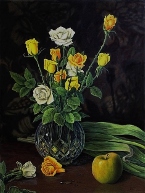
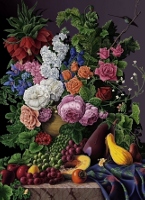

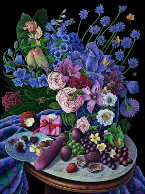

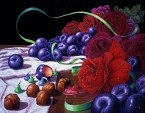
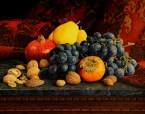
|
Ron
Marlett has been producing works in the still life genre since the
early 1990s, when he completed Roses and an Apple (1993). Since that
time still life has become a key pillar of Ron's artistic expression.
He has produced numerous, well-accepted examples in recent years, and
continues to pust forth significant material, exploring the creative
possibilities inherent in this fascinating form.
What is Art?
This
essay was written by Ron Marlett as a requirement for one of his art
classes at California State Universty, Northridge. The essay reflects
Ron's belief that art is a visual language that lifts our
spirits and enriches our lives. |
For as long as there has been art, there have been critics arguing over
what qualifies as art. Does the art mirror reality, or does it
represent ideal beauty? Does art reflect great skill and craftsmanship,
or is it a way for everyone to indulge in their creativity? Learning
about the elements and principles of design helps us develop a critical
eye about who is a trained artist and who is not, but does the
knowledge of design help us define what art is? People are obsessed
with comparing one thing to another, such as realistic art verses
abstract art. Fans of realism claim that abstract artists are nothing
more than monkeys let loose in an art supply store, and fans of modernism claim realistic artists are mere illustrators who
lack skill and inventiveness to go beyond the boundaries of
reality. To define what art is, it is important to understand why art
comes into existence. There are three forces that bring art into our
world; the need for people to create art, the need for people to see
beauty, and the need for people to have meaning in what they see.
The artist can be anyone in any culture who is applying their
creativity toward producing objects that are desirable by the artist
and the artist's patrons. The artist does not have to be famous in
order to create desirable art. One of the most famous works in Western
tradition is the marble sculpture Aphrodite of Melos (150 BC), yet the
Greek artist who created the piece is unknown to art historians.
Thousands of unknown artists from around the world , such as the Aztecs,
Africans, and Indonesian cultures, have created beautiful works of art
that gave its citizens a unique identity. Famous artists such as
Katsushika Hokusai, Helen Frankenthaler, and Norman Rockwell, provided
the world with individual perspectives on how they expressed creative
genius. Many famous artists helped change the visual world we live in
by creating imagery that went beyond the well-entrenched
conceptions of art. All artists have one thing in common, and that is
to create something beautiful that enriches the world they live in.
Beauty has always been linked to how we think about art.
Aesthetics is a philosophy that studies art and the nature of beauty.
For many centuries, the nature of beauty was determined by Western
traditions in regards to how well the artist imitated life. In the 20th
century, the world became easily accessable to ethnologists who
discovered that the concept of beauty differed in various cultures. In
Tahiti, islanders live in a garden paradise that is filled with bright
tropical colors. Bright color plays an extremely important roll in how
Tahitians make aesthetic judgements on art. In Africa, the artists
drifted away from art that illustrated the real world in favor of art
that represented their metaphysical beliefs. The religious reality that
Africans saw in their dreams became influential in how they developed
critical opinions on art. Creating an aesthetic measuring stick based
on international ideas of beauty can be helpful in understanding what
art is, but there will always be an artist who wants to challenge
society's rule book. In Quinten Massys' piece Grotesque Old Woman
(1520), the artist created a beautifully rendered painting of an ugly
old woman. When looking at the painting, it becomes obvious that the
artist was interested in making a statement about human pride and
vanity.
Art has meaning to it. Even if an artist created a piece
of art
that had no conceptual ramifications embedded into its imagery, we
would find meaning in it, because art inspires
interpretations that are wide ranged and diversified as our
personal experience makes them. Art has multible or ambiguous meanings
and may speak to individual viewers in different ways at different
times in history. In Pieter Breughel's painting Landscape with the Fall of Icarus
(1560), Breughel paints Icarus' death as an unenventful incident that
no one notices. The artist trivializes the tragedy by placing
Icarus in the far right side of the painting's background. Icarus
is shown just hitting the water, and his legs and a tiny splash are all
that can be seen of him. Breughel focuses his composition on painting
farmers, fishermen, and sailors going about their business - people who
are completely oblivious to Icarus falling into the ocean. Breughel's
painting loudly proclaims, "A man dies and the world hardly blinks."
Wystan Hugh Auden made a more generous interpretation in his poem
entitled Musee des Beaux Arts (1938). Auden wrote the poem after seeing Landscape with the Fall of Icarus
hanging in the Royal Museum in Brussels. The emotional impact the
painting had on Auden enlightened him on how easy it is for people to
become apathetic toward others who are suffering. Auden writes:
In Breughel's Icarus, for instance: how everything turns away
Quite leisurely from the disaster; the ploughman may
Have heard the splash, the foresaken cry,
But for him it was not an important failure; the sun shone
As it had to on the white legs disappearing into the green
Water, and the expensive delicate ship that must have seen
Something amazing, a boy falling out of the sky,
Had somewhere to get to and sailed calmly on.
Breughel's painting of Icarus
inspired Auden to think about the ugly side of humanity. In 1938, Nazis
were in control of Germany and Auden was aware of Germany's hostility
toward Jews. The ones who read Auden's poem Musee des Beaux Arts
could have been inspired to participate in the destruction of Nazism in
an attempt to prove Breughel wrong. Auden's emotional response to
Breughel's painting of Icarus
inspired Auden to create a poem that, in
turn, helped his contemporaries make a choice between apathy and
empathy in the wake of Nazi cruelty. Breughel's art had meaning that
touched future generations beyond his century. Art communicates ideas
through imagery that can be read as a visual language. Our first
connection we make with the visual language is our natural attraction
toward realistic art. Realism is easy to understand because the visual
language uses imagery that is recognizable in the world we live in. Art
becomes a form of entertainment where we learn to recognize the works
of great artists. We learn about the artists' lives and the times in
which they lived in. Art has a unique way of communicating through its
elements and principles of design. Learning about elements and
principles of design helps us to appreciate the modern movement that
began in the late 19th century. It was never intended for modern art to
replace realism and decorative art, but rather, add to the visual
language that we already understand. With art education, the definition
of art is widened to be inclusive of all human creativity so that when
we visit an art museum, the inspirational experience of understanding
the language of art's many styles will lift our spirits and enrich our
lives.
|
|





